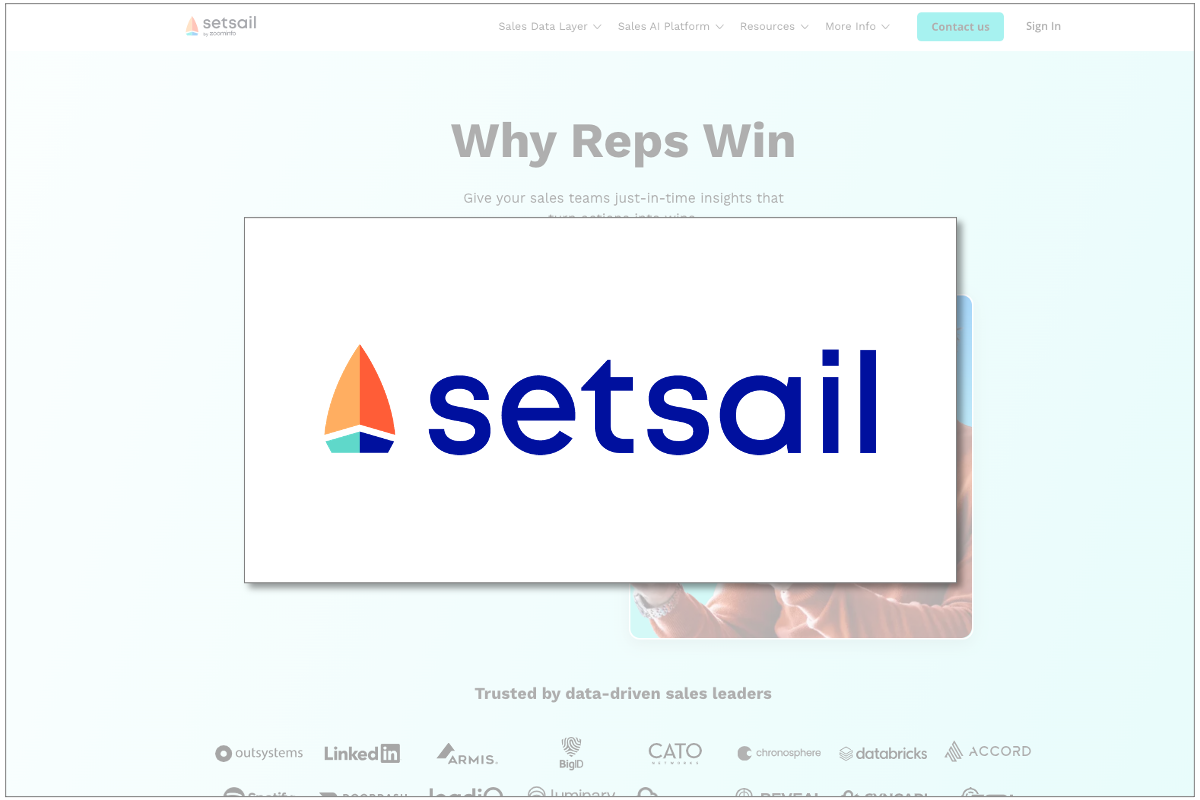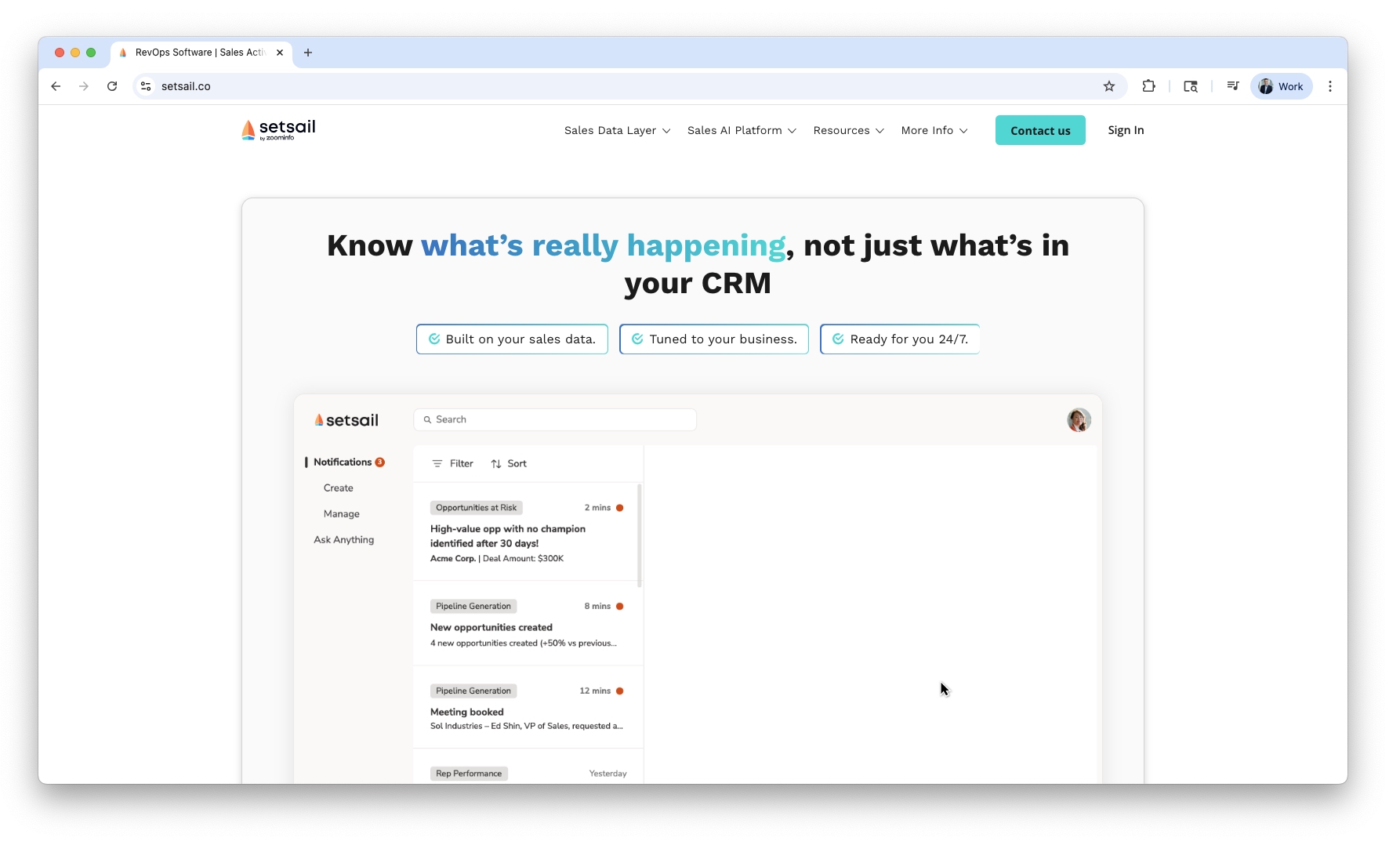


SetSail is an AI-driven revenue intelligence platform that analyzes sales behaviors to identify which actions truly drive closed deals. Instead of just tracking activity, it uses machine learning to surface patterns, reward high-impact behaviors in real time, and provide managers with actionable coaching insights. By focusing on behavioral science rather than vanity metrics, SetSail helps sales teams connect daily actions directly to revenue outcomes.
Subscribe now and get instant access to the best AI sales tools and walkthroughs.

SetSail is not just another sales dashboard; it’s a behavioral intelligence engine that aims to turn every customer interaction into a measurable driver of revenue. Where most sales tools focus on “more calls, more emails, more activity,” SetSail goes deeper, using AI to uncover which specific actions actually correlate with winning deals. Think of it as a cross between a data scientist, a revenue coach, and a gamified motivational platform that runs invisibly behind the scenes of your CRM. Instead of rewarding reps for simply logging activity, SetSail identifies the subtle buyer signals and rep behaviors that truly move the needle, then rewards those in real time.
At its heart, SetSail is built to answer one of the most frustrating questions in sales leadership: What really drives revenue? Rather than leaving it to anecdotal manager feedback or lagging quarterly reviews, SetSail uses machine learning to analyze patterns across deals, accounts, and reps, surfacing actionable insights and nudges daily. It’s less about vanity metrics and more about revenue causality. For teams tired of living in “gut feel” land, this tool brings hard data into the coaching conversation.
SetSail is designed for modern revenue teams that want to make their sales process smarter, more data-driven, and tied to actual outcomes.
- Sales Leaders: If you’re tired of seeing a flurry of activity reports but still missing your number, SetSail helps you separate busywork from behaviors that actually close deals.
- Revenue Operations & Enablement: Perfect for RevOps teams who want to connect CRM data, engagement tools, and pipeline movement into a single behavioral map without endless spreadsheet gymnastics.
- Account Executives & SDRs: Reps benefit from real-time feedback on what’s working and what’s not, instead of vague post-mortem coaching. The instant rewards for high-impact actions turn everyday selling into a game that actually pays off.
- Organizations with Complex Sales Cycles: If your deals involve multiple stakeholders, long nurturing cycles, and subtle buying signals, SetSail’s AI helps cut through the noise and identify which moments truly matter.
In short, it’s not a fit for every team—if your sales process is still in its infancy or your CRM hygiene is questionable at best, SetSail will hold up a mirror you may not be ready for. But for mature sales organizations ready to scale intelligently, it’s a powerful addition.
Driving Consistent Rep Behavior
Reinforce winning actions daily, turning anecdotal coaching into data-backed guidance.
Risk Detection
Spot deals that are silently going cold based on missing buyer signals or behavioral gaps.
Coaching Optimization
Equip managers with actionable insights on what separates top performers from the rest of the team.
Incentive Program Modernization
Replace outdated quarterly SPIFs with micro-incentives tied directly to revenue-driving actions.
Revenue Ops Analysis
Align marketing, sales, and customer success data to understand the true drivers of revenue without manual reporting.
Enterprise Sales Motions
Map complex, multi-stakeholder deals and surface which engagement patterns correlate with closing big-ticket opportunities.
- Behavioral AI Engine: Instead of focusing on sheer activity volume, SetSail’s machine learning models identify the specific behaviors that correlate with revenue outcomes. For example, it can tell you that looping in a CFO within the first two meetings increases your close rate by 40%. That’s actionable intelligence, not vanity metrics.
- Real-Time Micro-Rewards: Traditional sales incentives are delayed and disconnected. SetSail flips that model by delivering instant, automated rewards when reps perform revenue-driving actions. It’s Pavlovian psychology for quota crushers.
- Revenue Signal Detection: The platform doesn’t just track rep activity; it monitors buyer engagement signals (email opens, meeting cadence, stakeholder involvement) and uses AI to flag deal health and next steps.
- Automated Coaching: Managers get instant visibility into what top performers are doing differently and receive AI-generated coaching cues to replicate those behaviors across the team.
- Unified Data Layer: Sits on top of your CRM, email, and call tools to create a single source of truth for behavior-to-revenue mapping. No more manual data wrangling.
- Flexible Scoring Models: Lets you build custom scoring rules for different segments, deal sizes, or sales motions, making it adaptable to diverse go-to-market strategies.
PROS
- AI doesn’t just track activity—it identifies patterns that predict revenue with remarkable accuracy.
- Real-time micro-rewards keep reps engaged and motivated in the moment instead of waiting for end-of-quarter bonuses.
- Connects seamlessly with CRMs, email systems, and call platforms to create a unified view of sales behavior.
- Turns buyer engagement signals into actionable next steps instead of static dashboards.
- Provides managers with AI-powered coaching insights based on what top performers are doing differently.
CONS
- Requires a critical mass of historical and ongoing data to fully leverage the AI—small teams may see slower ROI.
- The gamification layer, while effective, can feel like “Big Brother meets Candy Crush” if rolled out without cultural buy-in.
- Pricing skews toward mid-market and enterprise; not as friendly to budget-conscious SMBs.
- AI recommendations are only as good as the data quality—if your CRM is messy, the insights will reflect that.
- Some early insights may feel obvious until the system learns your unique sales patterns.
One of the most impressive aspects of SetSail is that it doesn’t just layer AI on top of an existing reporting tool—it’s built from the ground up around machine learning and behavioral science. The platform doesn’t stop at saying “this deal is at risk” or “your reps aren’t sending enough emails.” Instead, it analyzes thousands of data points across calls, emails, and CRM interactions to determine why deals are won or lost, and then translates that into actionable coaching. That’s a huge step beyond traditional sales dashboards that dump static data in your lap and call it a day.
We also liked how SetSail rewards good sales behavior in real time. The micro-incentives system turns what is normally a lagging process (getting recognition or a bonus at the end of the quarter) into immediate feedback that actually drives motivation day-to-day. It makes the sales process feel less like running a marathon in the dark and more like having mile markers and water stations every step of the way.
Another highlight is the platform’s ability to make managers more effective without making them data scientists. The coaching dashboards distill complex data into simple, actionable recommendations. For example, it might show that top performers in enterprise accounts engage a CFO within the first 10 days and recommend that pattern across the team. Instead of spending hours building reports, managers can spend that time actually coaching.
We were also impressed with how SetSail integrates with existing tools. Instead of asking teams to rip and replace, it overlays on top of CRMs, email tools, and call platforms, creating a unified behavioral data layer. That makes adoption smoother and less disruptive while delivering immediate visibility.
Finally, SetSail’s AI gets smarter the longer you use it. Early insights are solid, but after a few months, the machine learning models begin to uncover patterns unique to your team and sales motion. It’s one of those rare tools that delivers more value over time instead of plateauing after the onboarding honeymoon.

While SetSail is powerful, it’s not a magic wand—and that can catch some teams off guard. The platform’s effectiveness is directly tied to the quality of your CRM and engagement data. If reps aren’t logging calls or updating opportunities consistently, the AI will essentially be learning from a messy sandbox. In that sense, it’s brutally honest: if your sales process and data hygiene are weak, SetSail will shine a very bright light on it.
The real-time rewards, while innovative, also require cultural finesse to roll out effectively. In the wrong environment, gamification can feel forced or even patronizing to experienced reps who view their work as strategic rather than transactional. Without clear communication on why the system exists and how it ties to revenue outcomes, it risks coming across as “Big Brother with a leaderboard.”
Another drawback is that SetSail takes time to hit full stride. In the first 30–60 days, the AI may surface patterns that feel obvious or generic because it’s still learning. The real gold comes after it has seen enough of your team’s specific deal cycles to start spotting subtle correlations. That means leadership has to have the patience to let the system learn before expecting mind-blowing insights.
Pricing is another consideration. While ROI can be substantial for mid-sized and enterprise teams, the platform isn’t cheap. Smaller companies or early-stage startups may find the cost prohibitive unless they are already operating at scale with a strong data foundation.
Lastly, while the dashboards are well-designed, there’s a learning curve to understanding the behavioral scoring models. Managers who are used to traditional “call counts” and “pipeline value” metrics may need a mindset shift to fully embrace SetSail’s behavioral-first approach. That shift pays off in the long run, but it can create friction in the early stages of adoption.
SetSail’s pricing is custom and aimed squarely at mid-market and enterprise sales teams. Expect a per-seat license combined with a platform fee, scaling with data volume and integration complexity. It’s not positioned as a low-cost SMB tool; instead, it leans on demonstrable ROI. Teams that use it effectively often recoup the cost through improved win rates and faster deal velocity, but if you’re a 3-person startup with inconsistent CRM data, the investment may feel steep.
%20(1)%20(2).png)